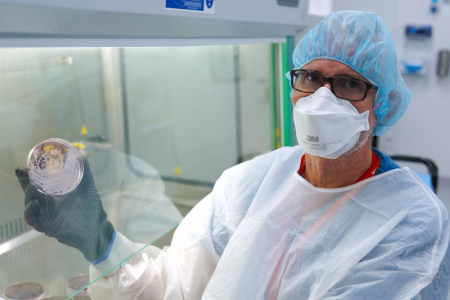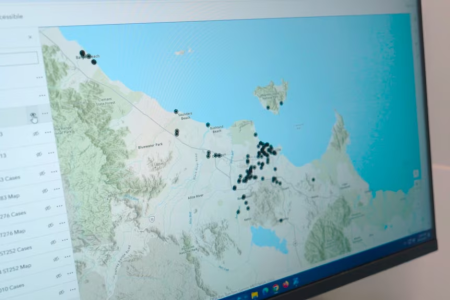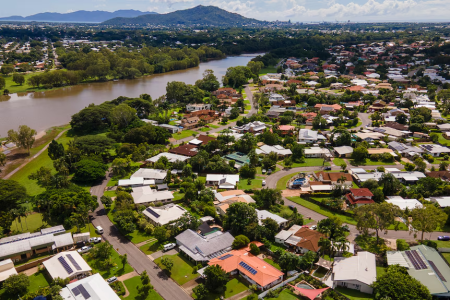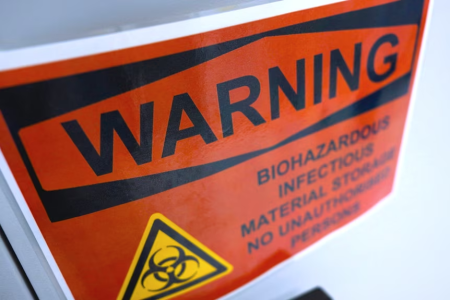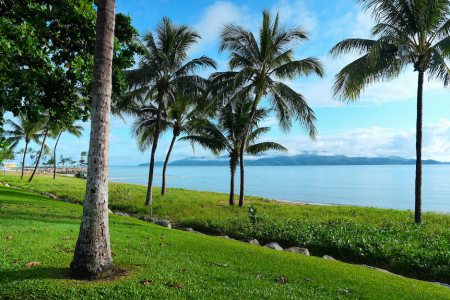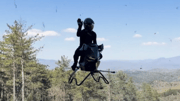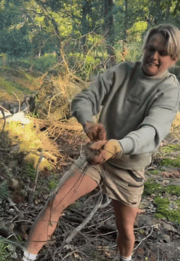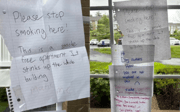Queensland scientists racing against clock to tackle 'unprecedented' environmental threat of melioidosis
By
ABC News
- Replies 0
Under the hum of filtered air and fluorescent light in an air-locked university lab, Jeff Warner lifts an agar plate to eye level, inspecting its potentially deadly contents.
Tilting the violet dish in his double-gloved hand, he notes several streaks of pink — a cross hatching of colonies; tiny microbial clusters teeming with life, invisible to the naked eye.
The distinct colours and formations are instantly recognisable to him: it's the killer bacterium linked to 30 deaths in a 'mysterious' and unprecedented outbreak that's devastating Queensland families and putting immense pressure on regional hospitals.
'This organism has currently killed almost one in five people who have acquired it from the environment, here in Cairns and Townsville,' Associate Professor Warner told 7.30.
The veteran microbiologist first came across the disease close to 30 years ago and is now considered a global research leader on the topic, based at James Cook University in the tropical north.
'You can toy with the words all you want,' he says.
The bacterium on the plate is Burkholderia pseudomallei, classified by the US Centers for Disease Control and Prevention as a Category B biowarfare agent, for its high fatality rate and its potential to be aerosolised and weaponised.
In Queensland, however, the threat isn't theoretical or military. It's real and environmental — lurking in soil and muddy water, stirred up by flooding rains and inhaled, ingested, or entered into the bloodstream through cuts and scratches.
For the unlucky, it leads to melioidosis — a virulent disease that enables chronic skin ulcers, sepsis, and serious lung infections like pneumonia. If left untreated, or diagnosed too late, it can be fatal.
'It replicates [and] produces proteins that are toxins to our body, and that's fundamentally what causes the fatality,' Professor Warner said.
The bacterium is typically confined to tropical climates where it thrives in heat and humidity, but scientists and health authorities are increasingly concerned it could be pushed further south as Australia's climate warms and our urban footprint expands.
'In the end, we don't really know why so many cases have happened,' he said.
In the water and on the move
In Townsville, a different pattern is emerging. The city has long been considered the unofficial home of melioidosis — early cases of the disease were once clustered around Castle Hill, the city's granite monolith.
Dr Warner says that is no longer the case.
In recent months, new clusters have surfaced north of the city — Professor Warner believes they are not random.
He suspects the bacterium is moving, and is investigating if it is changing in the same way a flu can, becoming better adapted to the climate, the people who live in the area, or both.
'We have proven in the past that the organism is available in ground water as it goes through Castle Hill,' Professor Warner said.
'That's now changed the actual demographic and the case notifications [have] now quite substantially changed.
'Why has it changed? Have we got any evidence that it's moving? We don't ... so the missing link in melioidosis research is ... trying to understand the environmental microbiology of the disease.
'Until we do, we're not going to be able to really develop good quality, targeted [and] informed public health messaging to actually help people understand risk.'
Given its presence in groundwater, Professor Warner says that may explain how cases have spread.
'Water seems to be important in the organism's mobility,' he explained.
'We all know that when the wet season breaks, you smell the rain.
The working theory is the bacteria is liberated by rising water tables and during extreme rainfall, then able to spread into rivers and creeks, and carried over long distances. Once settled in new terrain, it can survive — and thrive.
In Townsville, researchers have already matched strains of the bacterium found in local watercourses to those found in infected patients. But whether that water is the direct source of human infection is still unknown.
'That's what we are embarking upon, for the first time ever in North Queensland,' Professor Warner says, out to solve the 'fundamental mystery' of melioidosis.
'Where you get it from, what behaviour encourages transmission and does climate and environmental change affect disease patterns?'
Professor Warner also believes there's merit in a theory by public health physician Dr Simon Smith, which hypothesises that an upgrade to the Bruce Highway, south of Cairns, has contributed to a sudden increase in melioidosis cases due to it disrupting the soil.
'You tend not to see this organism in the soil environment where we've got highly fertile soils,' he said.
'That's probably because it gets out-competed by other organisms which really enjoy fertility and high nutrition.'
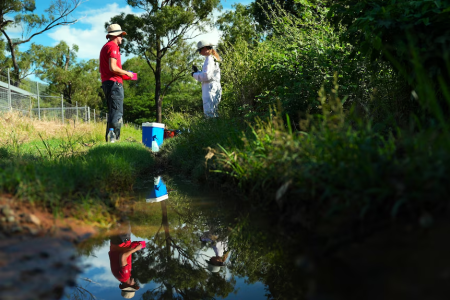
The public health conundrum
With a $1.5 million federal grant, Professor Warner is now leading a five-year investigation to trace the organism's movements.
The project will unite clinicians and scientists from across the north, including Menzies School of Health Research in Darwin, and teams in Cairns and Townsville, with assistance from several university and phd students.
Thousands of environmental samples will be taken across northern Australia, while genomic and spatial data will help map exactly where the organism persists — and predict where it might emerge as the climate becomes warmer.
The ultimate goal is to move beyond broad warnings and into tailored public health messaging.
'There is essentially very limited evidence to describe where people get this disease, what behaviour encourages transmission,' Professor Warner said.
Professor Warner's optimism belies concerns the state government, and the health minister, headquartered 1,300 kilometres away, are not giving this outbreak the deserved attention, with zero dollars from the coffers on the table.
'Melioidosis is a disease that describes very well the differences between urban and rural health expectations,' he said.
'The disease is very rare in capital city populations, but in regional northern Australia is one of the leading causes of fatal bacterial pneumonia and blood poisoning, that particularly affects the elderly and vulnerable people and their communities.
'If we're fair dinkum about Australians looking after the underprivileged, there's lots of things we can do better for regional communities, and that includes our leaders investing more.'
A Queensland Health spokesperson confirmed to 7.30 there was no extra funding in the pipeline for melioidosis research.
In Cairns, infectious diseases expert Dr Simon Smith suggested information-sharing between district health services needs to be urgently improved.
'I think it's really key that we start working more closely with our colleagues in Townsville and Darwin … that we join together and pool our resources to try and identify why we're seeing this large increase in northern Queensland,' Dr Smith said.
Written by Tom Hartley, ABC News.
Tilting the violet dish in his double-gloved hand, he notes several streaks of pink — a cross hatching of colonies; tiny microbial clusters teeming with life, invisible to the naked eye.
The distinct colours and formations are instantly recognisable to him: it's the killer bacterium linked to 30 deaths in a 'mysterious' and unprecedented outbreak that's devastating Queensland families and putting immense pressure on regional hospitals.
'This organism has currently killed almost one in five people who have acquired it from the environment, here in Cairns and Townsville,' Associate Professor Warner told 7.30.
The veteran microbiologist first came across the disease close to 30 years ago and is now considered a global research leader on the topic, based at James Cook University in the tropical north.
'You can toy with the words all you want,' he says.
The bacterium on the plate is Burkholderia pseudomallei, classified by the US Centers for Disease Control and Prevention as a Category B biowarfare agent, for its high fatality rate and its potential to be aerosolised and weaponised.
In Queensland, however, the threat isn't theoretical or military. It's real and environmental — lurking in soil and muddy water, stirred up by flooding rains and inhaled, ingested, or entered into the bloodstream through cuts and scratches.
For the unlucky, it leads to melioidosis — a virulent disease that enables chronic skin ulcers, sepsis, and serious lung infections like pneumonia. If left untreated, or diagnosed too late, it can be fatal.
'It replicates [and] produces proteins that are toxins to our body, and that's fundamentally what causes the fatality,' Professor Warner said.
The bacterium is typically confined to tropical climates where it thrives in heat and humidity, but scientists and health authorities are increasingly concerned it could be pushed further south as Australia's climate warms and our urban footprint expands.
'In the end, we don't really know why so many cases have happened,' he said.
In the water and on the move
In Townsville, a different pattern is emerging. The city has long been considered the unofficial home of melioidosis — early cases of the disease were once clustered around Castle Hill, the city's granite monolith.
Dr Warner says that is no longer the case.
In recent months, new clusters have surfaced north of the city — Professor Warner believes they are not random.
He suspects the bacterium is moving, and is investigating if it is changing in the same way a flu can, becoming better adapted to the climate, the people who live in the area, or both.
'We have proven in the past that the organism is available in ground water as it goes through Castle Hill,' Professor Warner said.
'That's now changed the actual demographic and the case notifications [have] now quite substantially changed.
'Why has it changed? Have we got any evidence that it's moving? We don't ... so the missing link in melioidosis research is ... trying to understand the environmental microbiology of the disease.
'Until we do, we're not going to be able to really develop good quality, targeted [and] informed public health messaging to actually help people understand risk.'
Given its presence in groundwater, Professor Warner says that may explain how cases have spread.
'Water seems to be important in the organism's mobility,' he explained.
'We all know that when the wet season breaks, you smell the rain.
The working theory is the bacteria is liberated by rising water tables and during extreme rainfall, then able to spread into rivers and creeks, and carried over long distances. Once settled in new terrain, it can survive — and thrive.
In Townsville, researchers have already matched strains of the bacterium found in local watercourses to those found in infected patients. But whether that water is the direct source of human infection is still unknown.
'That's what we are embarking upon, for the first time ever in North Queensland,' Professor Warner says, out to solve the 'fundamental mystery' of melioidosis.
'Where you get it from, what behaviour encourages transmission and does climate and environmental change affect disease patterns?'
Professor Warner also believes there's merit in a theory by public health physician Dr Simon Smith, which hypothesises that an upgrade to the Bruce Highway, south of Cairns, has contributed to a sudden increase in melioidosis cases due to it disrupting the soil.
'You tend not to see this organism in the soil environment where we've got highly fertile soils,' he said.
'That's probably because it gets out-competed by other organisms which really enjoy fertility and high nutrition.'

Dr Jeff Warner is leading a team of researchers to better understand the potentially deadly bacteria. (ABC News: Tom Hartley)
The public health conundrum
With a $1.5 million federal grant, Professor Warner is now leading a five-year investigation to trace the organism's movements.
The project will unite clinicians and scientists from across the north, including Menzies School of Health Research in Darwin, and teams in Cairns and Townsville, with assistance from several university and phd students.
Thousands of environmental samples will be taken across northern Australia, while genomic and spatial data will help map exactly where the organism persists — and predict where it might emerge as the climate becomes warmer.
The ultimate goal is to move beyond broad warnings and into tailored public health messaging.
'There is essentially very limited evidence to describe where people get this disease, what behaviour encourages transmission,' Professor Warner said.
Professor Warner's optimism belies concerns the state government, and the health minister, headquartered 1,300 kilometres away, are not giving this outbreak the deserved attention, with zero dollars from the coffers on the table.
'Melioidosis is a disease that describes very well the differences between urban and rural health expectations,' he said.
'The disease is very rare in capital city populations, but in regional northern Australia is one of the leading causes of fatal bacterial pneumonia and blood poisoning, that particularly affects the elderly and vulnerable people and their communities.
'If we're fair dinkum about Australians looking after the underprivileged, there's lots of things we can do better for regional communities, and that includes our leaders investing more.'
A Queensland Health spokesperson confirmed to 7.30 there was no extra funding in the pipeline for melioidosis research.
In Cairns, infectious diseases expert Dr Simon Smith suggested information-sharing between district health services needs to be urgently improved.
'I think it's really key that we start working more closely with our colleagues in Townsville and Darwin … that we join together and pool our resources to try and identify why we're seeing this large increase in northern Queensland,' Dr Smith said.
Written by Tom Hartley, ABC News.


